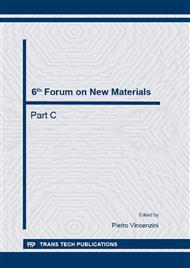p.66
p.72
p.78
p.84
p.91
p.96
p.100
p.107
p.113
Elucidation of Metal Diffusion Mechanism in Conducting-Bridge Random Access Memory (CB-RAM) Using First-Principle Calculation
Abstract:
It is important to specify the Cu diffusion path in the oxide layer of a Cu/oxide/Pt-structured conducting-bridge random access memory (CB-RAM), in terms of both the elucidation of resistive switching mechanism and optimization of memory performance. A first-principle calculation is effective in specifying the Cu diffusion path with atomic resolution. However, reported results of first-principle calculations are based on too simplified model to depict the actual system of CB-RAM. In this paper, a periodic slab model for the first-principle calculation of Cu diffusion process in HfO2-CB-RAM was proposed based on experimental results. Both the most probable Cu diffusion surface and Cu diffusion path were suggested by the first-principles calculations based on the model. It was also suggested that the Cu diffusion path was modified by introducing oxygen vacancy into the Cu diffusion surface.
Info:
Periodical:
Pages:
91-95
Citation:
Online since:
October 2014
Authors:
Price:
Сopyright:
© 2014 Trans Tech Publications Ltd. All Rights Reserved
Share:
Citation:


